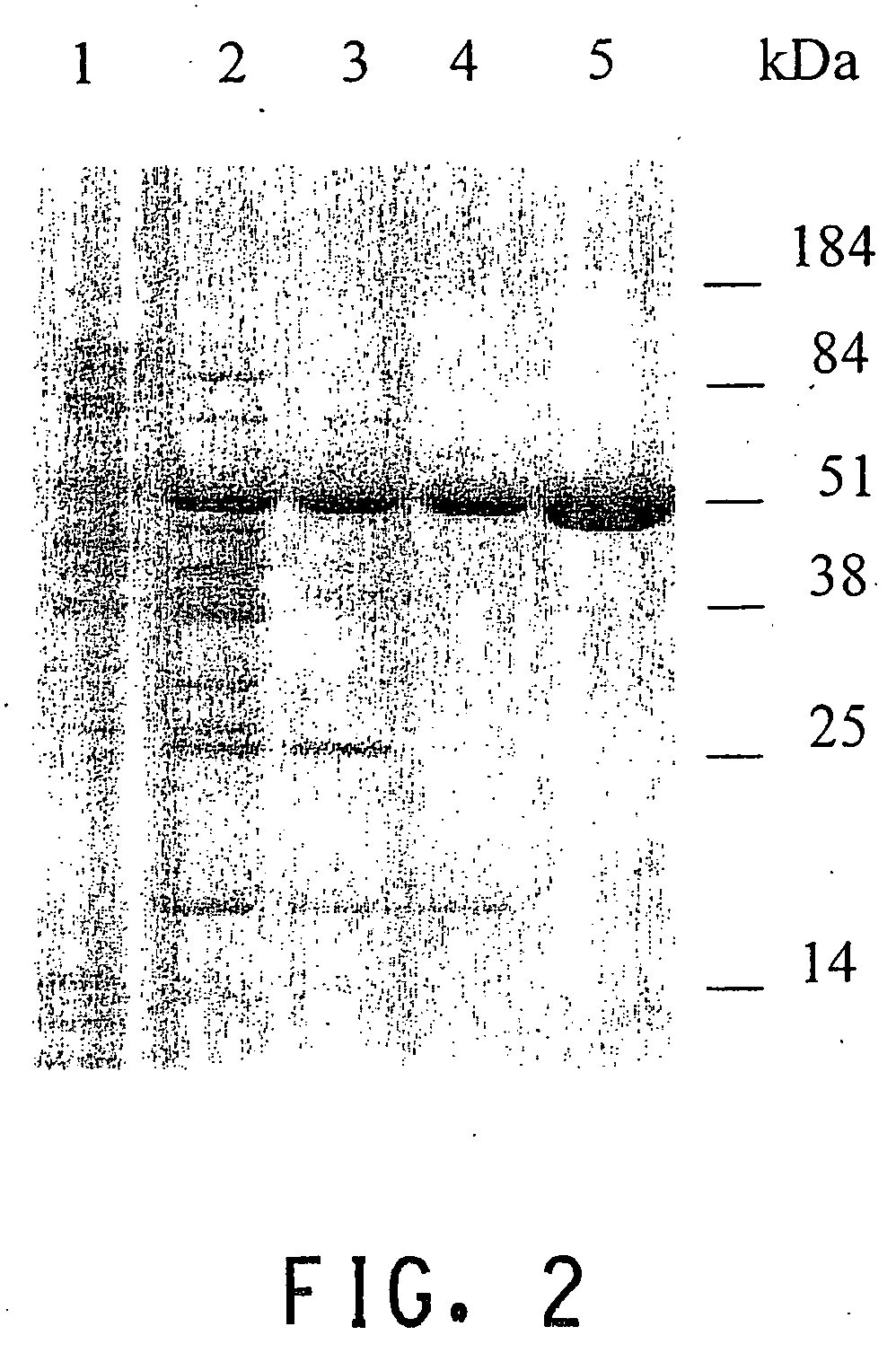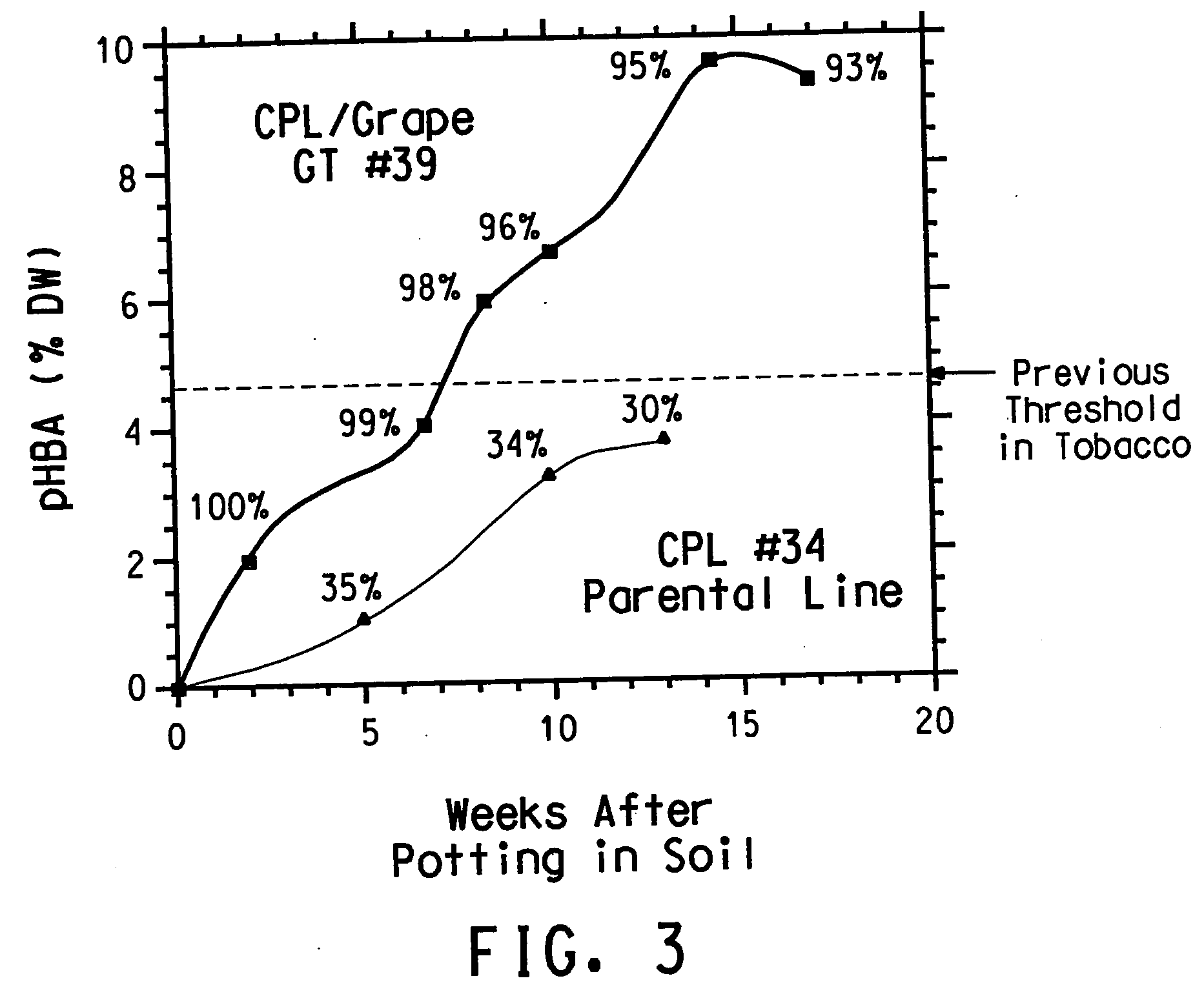UDP-glucosyltransferases
a technology of glucosyltransferases and nucleic acids, applied in the field of plant molecular biology, can solve the problems of lack of enzymes, living plants might not be able to tolerate high levels of certain compounds, and complex plants
- Summary
- Abstract
- Description
- Claims
- Application Information
AI Technical Summary
Benefits of technology
Problems solved by technology
Method used
Image
Examples
example 1
PCR-Amplification of the Brassica napus SA-GT Gene and Preparation of the Plasmid Construct Used for Expression in Escherichia coli
[0194] Two PCR primers were used to amplify the Brassica napus SA-GT from genomic DNA, while adding unique restriction sites to its flanking regions for subsequent ligation into an Escherichia coli expression vector. The target gene codes for a UDP-glucosyltransferase (GenBank® Accession number AF287143) that catalyzes the transfer of glucose from UDP-glucose to the carboxyl group of sinapic acid and several other hydroxycinnamic acid derivatives; this information was included as part of the annotation of the original GenBank® submission. The primers used to PCR-amplify the Brassica napus SA-GT consisted of the following nucleotides:
Primer 1-(SEQ ID NO:1)5′-CTA CTC ATT Tca tat gGA ACT ATC ATC TTC TCCTT -3′Primer 2-(SEQ ID NO:2)5′-CAT CTT ACT gga tcc TTA TGA CTT TTG CAA TAA AAGTTT T -3′
[0195] The underlined bases hybridize to the target gene, while low...
example 2
Cloning of Three Arabidopsis UDP-Glucosyltransferases (GT 3, GT 4, and GT 5) Closely Related to Brassica napus SA-GT
[0197] Two PCR primers were used to amplify an arabidopsis glucosyltransferase gene that corresponds to the nucleotide sequence given in GenBank® Accession number AL161541.2. The target for amplification was a cDNA clone (acs2c.pk012.b7) that was identified in Applicants' EST database. The primers used for this purpose consisted of the following nucleotides:
Primer 3-(SEQ ID NO:5)5′-CCA TAT CAG tca tga TGT TCG AAA CTT G -3′Primer 4-(SEQ ID NO:6)5′-GTC AAA GAC gtc gac CTA GTA TCC -3′
[0198] The underlined bases hybridize to the target gene, while lower case letters indicate the restriction sites (PagI or SalI) that were added to the ends of the PCR primers. Primer 3 hybridizes at the start of the gene and introduces a PagI site at the protein's initiation codon, while Primer 4 hybridizes at the opposite end and provides a SalI site just past the termination codon. The ...
example 3
Identification of the Grape GT and Preparation of the Plasmid Construct Used for Expression in Escherichia coli
[0203] To try to identify a plant glucosyltransferase that exclusively catalyzes the formation of glucose esters and has a high turnover number with pHBA as a substrate, the first 246 N-terminal amino acid residues of the Brassica napus SA-GT (SEQ ID NO:4) (GenBank® accession number AF287143) were used as a query sequence to probe Applicants' proprietary EST database. The tBlastn algorithm (Altschul et al., Nucleic Acids Res. 25:3389-3403 (1997)) with the standard default settings was employed for this search. Apart from two arabidopsis ESTs that correspond to sequences that are available in the public domain, the clone (vmb1na.pk009.c8) with the highest degree of homology (63 / 115 identical amino acid residues, E=1e−43) was obtained from a normalized cDNA library that was prepared from midstage grape berries (Vitis sp.). Since the cDNA insert in the plasmid vector appeared...
PUM
| Property | Measurement | Unit |
|---|---|---|
| Fraction | aaaaa | aaaaa |
| Fraction | aaaaa | aaaaa |
| Molar density | aaaaa | aaaaa |
Abstract
Description
Claims
Application Information
 Login to View More
Login to View More - R&D
- Intellectual Property
- Life Sciences
- Materials
- Tech Scout
- Unparalleled Data Quality
- Higher Quality Content
- 60% Fewer Hallucinations
Browse by: Latest US Patents, China's latest patents, Technical Efficacy Thesaurus, Application Domain, Technology Topic, Popular Technical Reports.
© 2025 PatSnap. All rights reserved.Legal|Privacy policy|Modern Slavery Act Transparency Statement|Sitemap|About US| Contact US: help@patsnap.com



